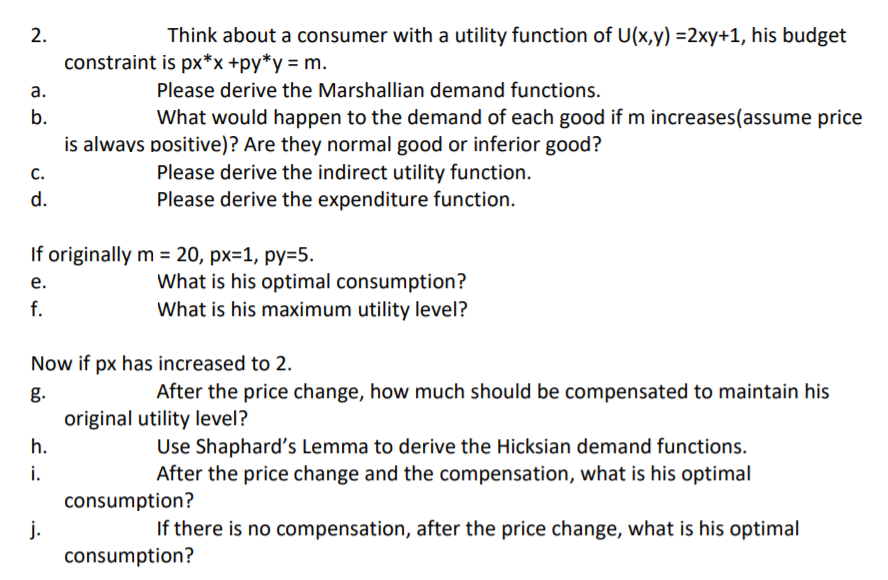2. Think about a consumer with a utility function of U(x,y) =2xy+1, his budget constraint is px*x +py*y= m. а. Please derive the Marshallian demand functions. b. What would happen to the demand of each good if m increases(assume price is alwavs positive)? Are they normal good or inferior good? Please derive the indirect utility function. Please derive the expenditure function. с. d. If originally m = 20, px=1, py=5. What is his optimal consumption? What is his maximum utility level? е. f. Now if px has increased to 2. g. After the price change, how much should be compensated to maintain his original utility level?
2. Think about a consumer with a utility function of U(x,y) =2xy+1, his budget constraint is px*x +py*y= m. а. Please derive the Marshallian demand functions. b. What would happen to the demand of each good if m increases(assume price is alwavs positive)? Are they normal good or inferior good? Please derive the indirect utility function. Please derive the expenditure function. с. d. If originally m = 20, px=1, py=5. What is his optimal consumption? What is his maximum utility level? е. f. Now if px has increased to 2. g. After the price change, how much should be compensated to maintain his original utility level?
Microeconomics A Contemporary Intro
10th Edition
ISBN:9781285635101
Author:MCEACHERN
Publisher:MCEACHERN
Chapter6: Consumer Choice And Demand
Section: Chapter Questions
Problem 15PAE
Related questions
Question
100%
I need answers E,F,G

Transcribed Image Text:2.
Think about a consumer with a utility function of U(x,y) =2xy+1, his budget
constraint is px*x +py*y = m.
а.
Please derive the Marshallian demand functions.
b.
What would happen to the demand of each good if m increases(assume price
is alwavs positive)? Are they normal good or inferior good?
с.
Please derive the indirect utility function.
d.
Please derive the expenditure function.
If originally m = 20, px=1, py=5.
е.
What is his optimal consumption?
f.
What is his maximum utility level?
Now if px has increased to 2.
g.
After the price change, how much should be compensated to maintain his
original utility level?
Use Shaphard's Lemma to derive the Hicksian demand functions.
After the price change and the compensation, what is his optimal
h.
i.
consumption?
j.
consumption?
If there is no compensation, after the price change, what is his optimal
Expert Solution
This question has been solved!
Explore an expertly crafted, step-by-step solution for a thorough understanding of key concepts.
This is a popular solution!
Trending now
This is a popular solution!
Step by step
Solved in 5 steps

Knowledge Booster
Learn more about
Need a deep-dive on the concept behind this application? Look no further. Learn more about this topic, economics and related others by exploring similar questions and additional content below.Recommended textbooks for you





